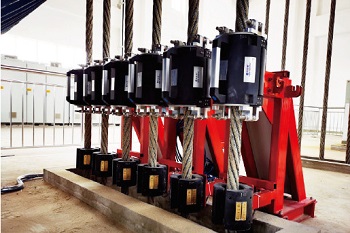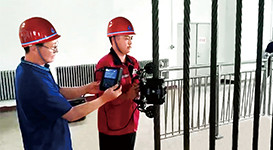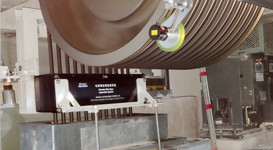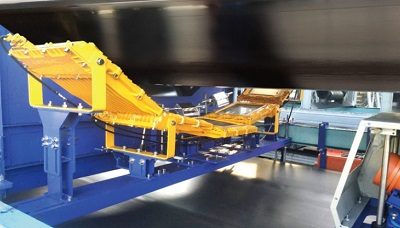
|

|

|

|
Using the world's advanced weak magnetic detection technology, it can accurately detect various hidden damages such as twitching of the steel wire rope core at the belt joint, breakage of the steel wire rope core in the non-joint area, and corrosion, which fundamentally solves the major detection problem of lateral fracture of the conveyor belt.
The strength of the vulcanized joint part of the steel cord conveyor belt often fails to meet the specified retention rate, making it the weakest and most vulnerable part of the entire belt in terms of tensile strength. Therefore, the majority of transverse fractures of conveyor belts occur at the joints, and there is almost no exception in the cases of belt breakage at home and abroad. There are many reasons for the damage and fracture of conveyor belt joints: incorrect coating, liquid application, wrong pressing temperature and pressure, corrosion of the end of the steel cord, and serious scratching or pulling. From a macro perspective, any cause of joint damage or even fracture will inevitably be accompanied by an increase in the deformation of the joint area and the occurrence of the twitching phenomenon of the steel cord core. When the local steel cord core twitches, all loads are concentrated on the non-twitching steel cord core. Over time, the local twitching steel cord core will gradually weaken, causing the entire load to be concentrated on the non-twitching steel cord core.
The number of rope cores increases, the area expands, the plastic deformation of the joints becomes larger and larger, the rigidity and strength become lower and lower, and finally all the steel rope cores are pulled out bare, resulting in joint fracture.
The TCK.W steel cord conveyor belt online real-time automatic detection system adopts the world's advanced weak magnetic detection technology, which can accurately detect various hidden damages such as twitching of the steel cord in the joint area of the conveyor belt, fracture of the steel cord in the non-joint area, and corrosion, thus fundamentally solving the major detection problem of lateral fracture of the conveyor belt.
1 Principles of weak magnetic detection technology
TCK's weak magnetic detection technology is a "green" non-destructive testing technology based on the "spatial magnetic field vector synthesis" principle, using a new electromagnetic-magnetoelectric effect sensor to achieve a non-destructive inspection of iron-magnetic components. The TCK high-sensitivity sensor is composed of a demagnetization element and a magnetic constant element. Due to the structural specificity of steel wire rope conveyor belts, the TCK steel wire rope conveyor belt online real-time automatic detection system uses a modular combination of horizontal + vertical sensor modules as the detection device: horizontal sensors can sensitively sense the length characteristics of metal distribution, so through the amplitude output of the horizontal sensor, it can achieve high accuracy in quantifying and detecting signals such as steel wire rope breaks (including joints), fatigue, corrosion, etc.; while vertical sensors are more sensitive to the dynamic characteristics of the metal part, such as joints, open signals of broken wires, etc., with steep wave slope, making location detection more reliable.
After the sensor array picks up the electromagnetic signal of the steel wire rope core in the conveyor belt, it is shaped, filtered, and converted into a digital signal through the corresponding technical module for A/D conversion and enters into a 32-bit ARM interrupt system. The two systems achieve synchronous spatial sampling and upload the sampled data to the display terminal and large-capacity storage devices in real-time.
The display unit and detection unit communicate through industrial Ethernet, which is compatible with either network cable or optical fiber transmission. While at the display terminal, a unique software architecture and advanced programming technology are used to achieve real-time transmission, processing, storage, and display of detection data from the field and main station front and rear ends. It also supports real-time alarming, curve analysis, SMS notifications, image reconstruction, and printing of inspection reports.
2 System workflow

3 System composition and characteristics
(l) The loading module of the solid Nd-Fe-B configuration in the device is designed without permanent magnets and intrinsically safe.
(2) Wide-range non-contact non-destructive loading, achieving zero emissions and zero energy consumption.
(3) The combined wild card unit is suitable for steel cord conveyor belts of different width specifications.
(4) The overall stainless steel frame structure has integrated rainproof, dustproof and shockproof performance.)
(5) Adaptive all-weather operation, daily maintenance-free.
3.2 TCK-GMS flameproof and intrinsically safe flaw detector
(1) Embedded low-power 32-bit industrial-grade CPU, high-speed data acquisition system, industrial-grade large-capacity storage.
(2) The modular combination wild card structure is suitable for steel cord conveyor belts of different width specifications.
(3) Truly achieve wide-range non-contact weak magnetic nondestructive testing, without affecting the normal production operation of the belt conveyor during testing.
3.3 TCK - GMS form encoder
The use of explosion-proof high-precision photoelectric encoders, as well as anti-loose mechanical structures, self-tightening floating cantilever supports, and integration of anti-vibration, pulse shaping, and other industrial design features, provide stable signals and high design accuracy.
3.4 TCK automatic control sound and light alarm device
Through EPLD photocell, DDY-6 buzzer alarm and software control, it can give early warning prompts for the safety status of the steel wire rope conveyor belt according to the detection data, and is equipped with three signal lights: green, yellow and red. Green light: the steel core belt is in a safe state; yellow light: there are local hidden dangers, and the steel core conveyor belt needs to be strengthened and maintained; red light: there are significant dangers, and the steel core conveyor belt is in a dangerous state, and it is necessary to immediately take measures such as stopping the vehicle, adjusting, replacing the new belt and other pre-set emergency plans.
3.5 TCK SMS Security Reporting Function Device
Based on real-time detection results and historical statistical data, alarm information can be displayed and locked on the terminal interface. According to the system's pre-determined lock, the corresponding alarm information can be remotely sent to the corresponding management personnel through the mobile phone module.
3.6 TCK multi-channel terminal master control device
(1) Multi-channel step-by-step exchange, synchronous transmission and reception high-frequency operation mode.
(2) Cable/wireless communication, cable/optical cable access can be configured as desired.
(3) The cabinet terminal supports the browser and server human-computer dialogue simple operation form.
(4) Windows system platform, TCK professional master control program control software drives the system to run fully, supporting multiple language operation interfaces.
(5) The goal of establishing a file-based management system and FIFO (first-in first-out) data structure is to collect, analyze, process, and transmit steel wire rope core detection data information during online banquets.
(6) Reconstruct the dynamic perspective image of the target based on the detection data using the mask animation technique.
(7) 14-channel signal curve synchronous segmented display.
(8) Pre-set real-time over-limit sound and light alarm, and remote notification via mobile phone text message.
(9) Support users to view and print various data information reports and results reports at any time.
(10) It can provide trend analysis of various potential safety hazards of steel cord conveyor belts and scientifically evaluate the intrinsic safety level of steel cord conveyor belts.
System innovation
(1) High resolution: The instantaneous detection accuracy of the displacement of the steel rope core joint reaches Imm, and it can automatically analyze the average and maximum displacement during each operating period, thereby accurately and effectively identifying the elastic and permanent displacements of the steel rope core joint of the conveyor belt.
(2) High sensitivity: The 5V/Gs high-sensitivity magnetic sensing component invented by TCK is more than 7,000 times more sensitive than ordinary Hall components, enabling reliable quantitative detection of various early safety hazards such as joint twitching, internal rope breakage, fatigue corrosion, and so on.
(3) System real-time performance: While highly integrating computer, intelligent software and communication technology for online quantitative nondestructive testing, the system can provide real-time alarm to indicate the safety status of the conveyor belt, and display holographic perspective images of the internal metal structure and defect distribution of the conveyor belt in real time.
(4) Precise positioning: The original horizontal + vertical response combined "sensor spatial array" can reliably achieve two-dimensional precise positioning of internal damage in steel cord conveyor belts, with a position error of less than l0 xl0mm.
(5) Image reconstruction: The TCK detection software dynamically constructs a belt steel wire rope core image based on the real-time data from the sensor, which is visually intuitive. It can accurately identify joint displacement, core breakage, corrosion, wear, and other faults using quantitative positioning, and provides signal prompts in different colors based on the severity of the damage, while also issuing alarm messages.
上一篇: Application Research on TCK·W Steel Cord Conveyor Belt Online Monitoring System
下一篇: 晋煤集团自动监测系统现场对比验证报告
The application of TCK.W wire rope detection technology in academic journals
Editor's note: TCK.W has developed a weak magnetic rope detection technology that can real-time monitor the status of steel ropes 24 hours a day, 365 days a year, and locate, classify, and quantitatively identify various internal and external defects. Currently, more than 2,500 clients in 42 countries worldwide are using this technology. These clients have published papers on the safety and economic benefits brought about by this new technology in various academic journals. Here is a compilation of some of these papers for experts and scholars to explore and study in depth.。
论文名称
作者单位

 publish:Shandong Coal Technology
publish:Shandong Coal Technology